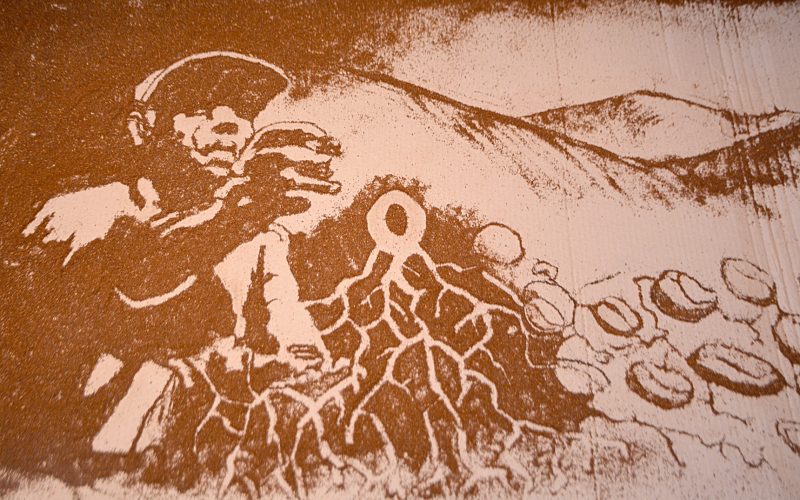
Photos by Janelle Jessen/Siloam Sunday
John Brown University student Annee Hofstra’s mural is made entirely from loose coffee grounds and beans. It shows the process of making coffee — from seed to cup.
By Janelle Jessen
Annee Hofstra’s student exhibit at John Brown University ties the community of coffee together — from seed to cup — with a room-sized mural made out of loose coffee grounds.
The exhibit, titled “Grounded,” is on display in the Windgate Visual Arts East student gallery until Friday — so, if you want to see it, time is of the essence. The gallery is open 8 a.m. to 4 p.m. Monday through Friday.

The beginning of Annee Hofstra’s mural shows how the farmer starts the process of producing coffee by planting a seed.
Hofstra, who has a double major in art and Spanish, created the mural as her senior honors capstone project. She hopes to increase viewer appreciation for the people who grow and produce coffee.
Society is in the midst of the third-wave coffee movement, Hofstra said. Part of the movement is seeing coffee as an art as well as an increased awareness of social issues in developing countries. Hofstra hopes the exhibit will make people think about how daily purchasing choices can make a difference in others’ lives.
An intense smell of coffee fills the entire Windgate Visual Arts East building. The artwork is created from 15 pounds of Mama Carmen’s coffee beans, both ground and whole. It tells the story of coffee and the people who grow, process and use it.

John Brown University student Annee Hofstra talked about the ideas behind her mural made of loose coffee beans. The mural is visible on the floor in the background.
Mama Carmen’s Coffee is a small roaster based in Fayetteville that is focused on ethical sourcing of coffee. It was inspired by a Guatemalan woman named Mama Carmen who runs an orphanage. Coffee is purchased directly from farmers, who receive a fair wage for their work.
“They value everyone who is part of the process,” Hofstra said.
Hofstra said she was inspired to use coffee grounds as a medium after doing research about Cyndi Gusler, a professor at Eastern Mennonite University, near Harrisonburg, Va., who makes artwork out of the medium it depicts.
The mural begins with images of the coffee being planted and growing into a tree, which flowers and grows coffee cherries. As viewers walk around the room they follow the journey coffee takes from harvesting and processing, to milling, exporting, roasting and finally the grinding and brewing process.
“Honestly, I don’t know how many of us consider the person who sorts the (coffee) beans as a real neighbor,” Hofstra said.
“She did a spectacular job,” said professor Bob Martin. “I’m really proud of her.”
Using coffee grounds as an art medium is pretty rare but artists do occasionally explore non-traditional ways to make art, Martin said.
Hofstra’s project began with a tremendous amount of research into the coffee production process.
It took her a week of focused work and the help of more than 10 friends to lay down all the coffee beans. She used Adobe Photoshop to lay out the design she planned for the space, melding photos and her own drawings into the mural. She then lightly sketched her design onto pieces of cardboard that were laid on the floor. Her friends helped her fill in the shapes with grounds, then she refined details, brushing away grounds to create highlights.
Hofstra said that charcoal is one of her favorite mediums and she used some of the same techniques of erasing away highlights to create detail in the coffee bean mural. She used sponge brushes, X-Acto knives and her hands to manipulate the coffee grounds.
Once the gallery closes on Friday, Hofstra plans to sweep the mural away, collecting as much of the coffee as possible for future use.
Martin was impressed by Hofstra’s willingness to take the risk of using a medium that is not permanent.
“It’s kind of a metaphor for the fragility of life and the coffee system,” he said.
Hofstra has a passion for the idea of community that has been evident in her other art projects as well, Martin said. Coffee ties people together in a community — from growers to consumers — even though they may be thousands of miles apart, he said. “She’s a deep thinker and constantly tries to show her faith and beliefs through her artwork.”
A video showing Hofstra’s entire mural is available at here.



